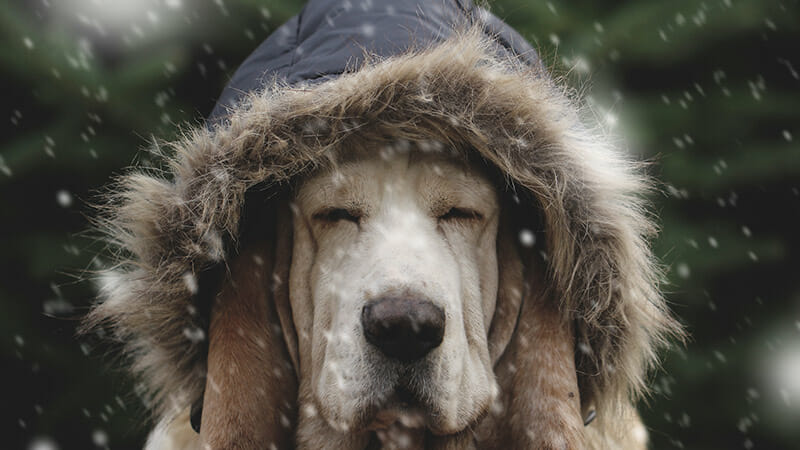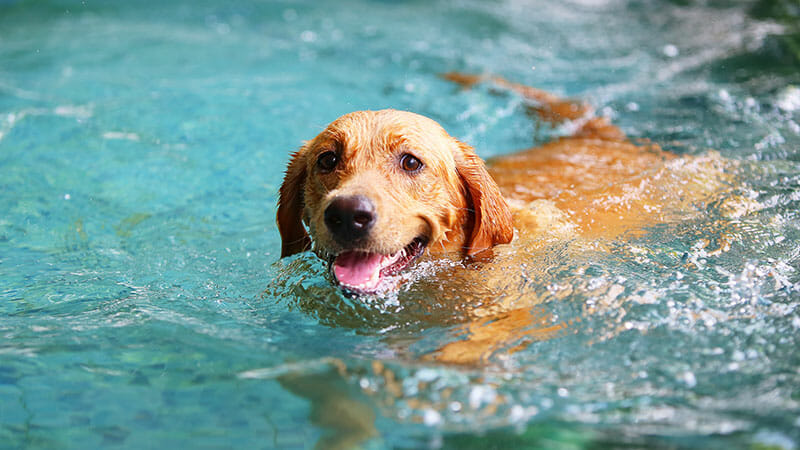When is it too cold for your dog? Most dogs will start to get uncomfortable around when temperatures fall near 32°F, but cold-averse breeds and vulnerable dogs might start feeling the chill at around 45°F. When the weather hits these temperatures, it’s important not to leave your dog outside for too long.
Our Top Tips for Keeping Your Dog Warm in Cold Weather
Follow these tips to make sure your dog stays comfortable and warm in these winter months!
1. Give Them a Warm Bed and a Cozy Blanket
A quality bed and fuzzy blanket can make a huge difference for your dog! Providing these two things for your dog to sleep on and nest in should be more than enough to help ward off the cold, but if your dog sleeps in a drafty or chilly part of the house, you might want to invest in a self-warming pet mat or a mat with a removable and microwavable heating pad.
If you have questions about heated pet beds and appropriate bedding for your dog, make sure to consult with your veterinarian, as they’ll be familiar with your dog’s needs.
2. Put Your Dog in a Jacket or Sweater
While some breeds with double-coats and long fur are suited to the cold—think malamutes and huskies—breeds with little to no hair will need some extra help. Greyhounds, Chihuahuas, whippets, and miniature pinschers are all great candidates for a doggie sweater when they’re outdoors and supervised.
Not all dogs are into wearing sweaters, which is just fine. If they won’t wear one, just limit the amount of time that they’re out in the cold, then make sure they warm up once indoors.
3. Make Sure Your Dog Has a Warm Outdoor Shelter
If your dog spends a lot of time outside, having an adequate shelter is extremely important. After a while, their ears, tail, nose, and paws can become susceptible to frostbite—which is painful and can cause permanent damage.
An adequate outdoor shelter should be dry and free of drafts, preferably enclosed. It should also be at least four inches off the ground and have a sloped roof to prevent the accumulation of snow and provide wind protection. For extra insulation, put down a layer of straw.
4. Protect Your Dog’s Paws
Your dog’s paws are more susceptible to cold than other parts of its body, so keep an eye on them. When your dog comes in from outside, check their paws for cuts and abrasions and wipe off any frost or snow. If your dog has long hair between their paw pads, trim it to prevent painful ice blocks from forming. You could also try out dog booties for extra protection!
If you notice your dog’s paw pads are drying out or cracking, consult your vet about a dog-safe moisturizer or protectant. Never use human lotion on your dog’s paw pads, as it could do more harm than good.
4. Protect Your Dog’s Paws
Your dog’s paws are more susceptible to cold than other parts of its body, so keep an eye on them. When your dog comes in from outside, check their paws for cuts and abrasions and wipe off any frost or snow. If your dog has long hair between their paw pads, trim it to prevent painful ice blocks from forming. You could also try out dog booties for extra protection!
If you notice your dog’s paw pads are drying out or cracking, consult your vet about a dog-safe moisturizer or protectant. Never use human lotion on your dog’s paw pads, as it could do more harm than good.
5. Ward Off Hypothermia
Just like humans who stay out in the cold for too long, dogs left outside can suffer hypothermia, a condition where their body temperature falls below normal levels.
Mild hypothermia can lead to weakness and inactivity, as well as shivering. As the condition worsens, your dog could become unresponsive as their breathing and heart rate slow. If you notice any of these symptoms, get your dog someplace warm and immediately take them to the vet. Keep your dog warm on the way there with a hot water bottle wrapped in a towel.
Extra Cold Weather Safety Tips for Your Dog
Dogs need daily exercise, even in cold weather. But remember to let their muscles warm up for the first five minutes. On very cold or inclement days, consider exercising your dog indoors. Long hallways are great for games of fetch!
Be careful of fireplaces and fire pits. Never leave a fire burning unattended, especially with your pet nearby. A screen can help to keep your dog away from hot soot, flames, and embers.
Make sure to properly store antifreeze by keeping it out of your dog’s reach. It has a sweet taste and is highly toxic to dogs.
Don’t leave your dog unsupervised in an area with a space heater. It could burn them if they get too close, but they could also tip it over and accidentally start a fire.
Don’t stop treating your dog for fleas and ticks when the weather gets cold. These parasites can survive in colder temperatures, especially if your dog spends a lot of time indoors where it’s still warm. For that reason, treat your dog for fleas and ticks—and heartworms—year-round.
Following our tips for keeping your dog warm in the winter month will help to keep your dog happy and healthy all year long!




